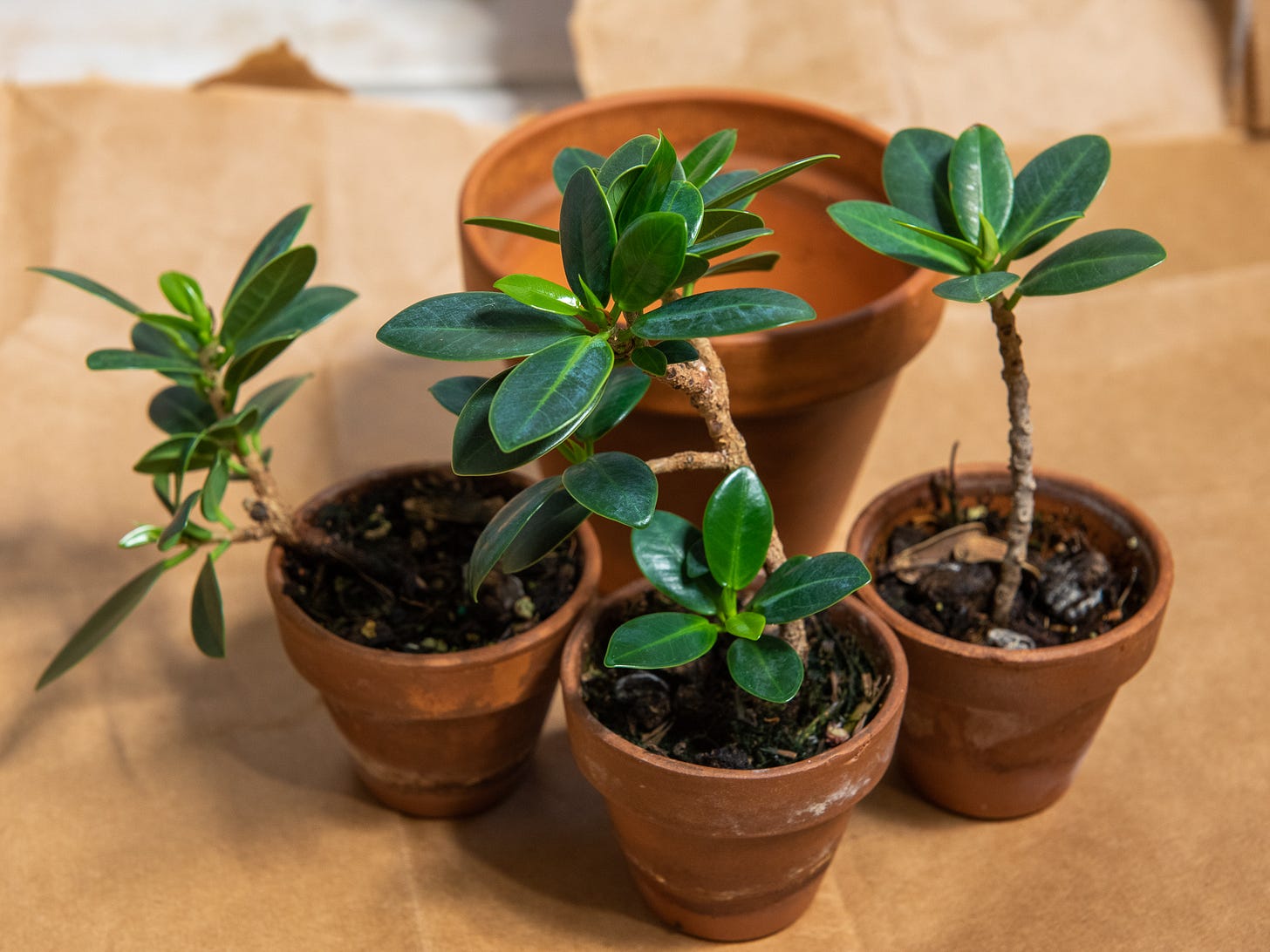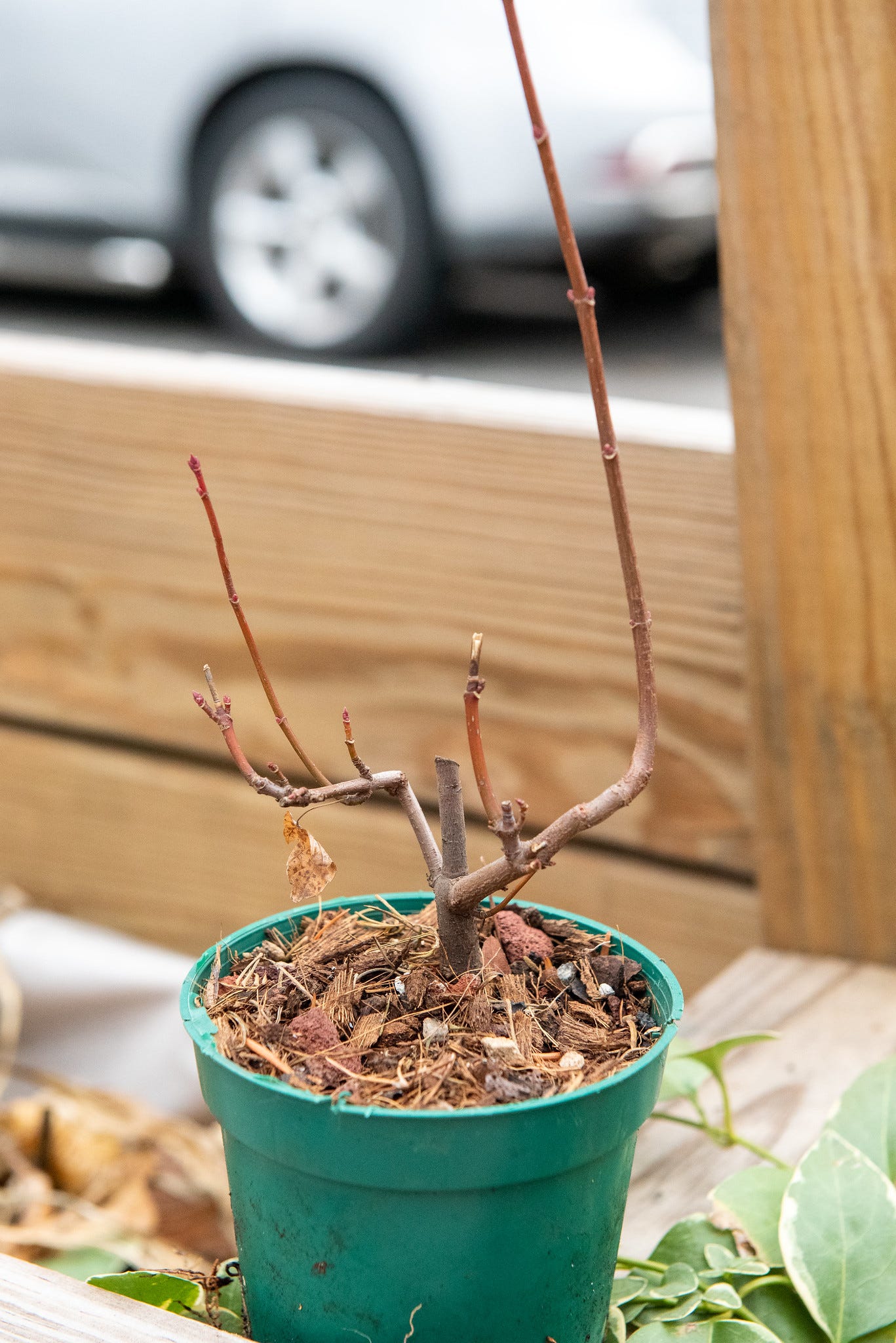One of my goals for 2023 is to spend as little money on bonsai as possible. I have plenty of trees, hardware, pots, and soil. Now I need to hunker and focus. So I’m excited to begin the new year by talking with you about my garbage mix.
In a corner of my kitchen sits an Ikea-sized reusable shopping bag filled with the detritus of a dozen houseplants. This perpetual stew of potting soil is my garbage mix. When I decide to toss a houseplant, the plant goes in the compost and the soil into my garbage mix. Leftover sphagnum moss from propagations; extra coco coir from mulching my outdoor trees; old mucky bonsai soil. All into the mix.
I use my garbage mix to up-pot houseplants and establish young cuttings. The soil has organic components that hold more water than straight bonsai soil, which is good for tropical foliage plants and for little fig trees I give to friends. It’s also handy for projects I want to keep on the back burner and not have to worry about watering every day. I’m running several ficus experiments that don’t require fast, ultra-vigorous root growth. The garbage mix isn’t ideal for bonsai, but works fine for slower growth. And unlike new bonsai soil, it’s free.
Most of the components in potting soil are reusable for as long as you’re willing to put up with them. That includes the main one, peat moss, which is the organic remains of decayed plants from peat bogs. Peat moss retains water and organic nutrients, yet doesn’t turn to muck. It’s easy to mine—you just dig chunks of it out of the ground—so it’s cheap, too. The commercial plant trade relies on peat. Virtually all of your houseplants have touched it at some point. Which is a problem.
Peat is a fascinating substance. It’s a dense, organic layer made of plant matter compressed over thousands of years. It can preserve pre-historic human remains down to the fingerprint and follicle. If petroleum is a fossil fuel, peat is a fossil soil. It’s so carbon-rich you can, in fact, use it as fuel; the smoky aroma of burning peat is the reason peaty Scotch tastes like it does. Peat bogs account for 3% of the Earth’s landmass, yet they sequester more carbon than all of our forests combined—twice over.
There’s lots of decomposed sphagnum moss in peat, but peat moss is no more moss than a pile of bones is a dog. It’s a clever naming trick, because when you think of moss you think of forest floors abundant with it. You don’t connect it to a precious gift of the earth that’s vital to our survival. You don’t have to worry about how casually it’s strip-mined from bogs, leaving barren soil and poisoned air in its wake.
So I like to reuse peat moss when I can. Over time it decomposes into smaller clay-like particles that suck up more moisture. A fresh addition to the garbage mix keeps it aerated.
The other main component of typical potting soils is perlite, which is the clumpy white stuff that looks like styrofoam. (Some cheap potting mixes do indeed use styrofoam in place of perlite, so I try to reuse that too.) Perlite is volcanic glass artificially heated until it puffs like popcorn. It adds structure to a peaty soil and provides air to plant roots. While it also crumbles over time, it’s still useful to bulk up my garbage mix.
Coco coir is the plant trade’s biggest alternative to peat moss. Coir (pronounced core, because no one told me at first) is the flossy brown threads of a coconut husk. This byproduct of coconut cultivation is usually thrown away or burned, but if the resilient fibers are cleaned and processed, they can be used as a substrate for growing plants; a waste product turned into something new. Unfortunately, the chemicals used in processing cause their own environmental damage, and coco coir producing regions are far more densely populated than northern European peat bogs. I use coarse coco coir to insulate my temperate trees. It drains easily and doesn’t break down; this makes it a good chunky addition to my garbage mix.
Over time, the nature of my garbage mix changes. It grows and it shrinks. Sometimes I add specific amendments for a task, like extra pumice from my pumice pile for a fragile rooted cutting. I may even buy additions specifically for the mix, like a recent purchase of 1/2-inch lava rock particles to give it better aeration for upcoming repots of some large plants. When young trees get promoted to pure bonsai soil, the old garbage mix is recycled back into the pile.
If all goes well, I won’t have to buy another bag of potting soil for the foreseeable future. I prefer my mix anyway. All the bonsai components make it more coarse and free draining than commercial potting mix, and 90% of houseplant problems come down to a soil retaining too much water.
As long as you keep your garbage mix dry, it’s inert and odorless. That’s why I prefer the open shopping bag in my kitchen. A couple of years ago, when I still had plants on my fire escape, I kept a pot of garbage mix outside. A family of pigeons moved in.
Tree reading
A quick primer on peat’s potential to mitigate the effects of climate change. [Nature]
The parasitic life cycle of mistletoe—the one you kiss underneath during Christmas—reads like a horror film. [US Geological Survey]





THANK YOU, Max, for this, and also for preventing me from saying "coco kwahr" out loud in front of someone, which was bound to happen eventually. <3